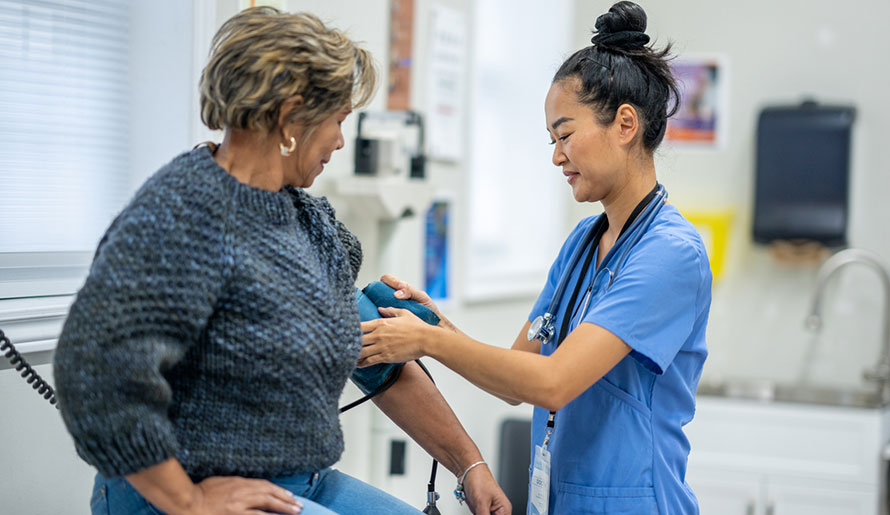Non-Hodgkin Lymphoma Causes and Risk Factors
Non-Hodgkin lymphoma is a diverse group of blood cancers that develop in the lymphatic system. This vast network of tissues and organs helps rid the body of toxins and excess fluid while playing a crucial role in its immune function. Unlike Hodgkin lymphoma, which is characterized by large, abnormal white blood cells (Reed-Sternberg cells), non-Hodgkin lymphoma is diverse in its manifestation and progression. Additionally, the cancer has several subtypes, which can vary significantly in terms of its aggressiveness and response to treatment.
Common symptoms of non-Hodgkin lymphoma include swollen lymph nodes, fever, night sweats, weight loss and fatigue. Treatment options can include chemotherapy, radiation therapy, immunotherapy and, in some cases, bone marrow transplantation (BMT).
What causes non-Hodgkin lymphoma?
Non-Hodgkin lymphoma arises from a mutation in the DNA of a lymphocyte, a type of white blood cell integral to the immune system. The cancer can originate in a B lymphocyte, which produces infection-fighting antibodies, or a T lymphocyte, which fights off bacteria, viruses and other harmful invaders. The mutation causes the cell to grow uncontrollably and survive beyond its normal lifespan, leading to an accumulation of abnormal cells in the lymphatic system. While the exact trigger of the cellular DNA mutation is not fully understood, scientists have identified genetic and environmental factors as potential contributors.
What are the risk factors for non-Hodgkin lymphoma?
Researchers are currently investigating several potential risk factors for non-Hodgkin lymphoma. A risk factor is a characteristic, behavior or exposure that increases the likelihood of developing the cancer but does not directly cause it.
Non-Hodgkin lymphoma risk factors that can be controlled
Certain risk factors for non-Hodgkin lymphoma can be influenced by lifestyle choices and environmental exposures, offering some degree of control in potentially reducing the risk. These include:
- Obesity – Along with poor nutrition and physical inactivity, excess body weight can lead to several potentially serious health issues, including cancer.
- Smoking – Tobacco use is a controllable risk factor for many types of cancer, including non-Hodgkin lymphoma.
- Infections – Because certain viral and bacterial infections are associated with an increased risk of non-Hodgkin lymphoma, practicing good hygiene and safe sex can have a protective effect.
- Exposure to chemicals – Certain pesticides, herbicides and other harmful substances used in agricultural and industrial settings have been linked to non-Hodgkin lymphoma.
Non-Hodgkin lymphoma risk factors that cannot be managed
Several Non-Hodgkin lymphoma risk factors are beyond individual control, including:
- Advanced age – Like most cancers, the risk of non-Hodgkin lymphoma increases with age. Most cases are diagnosed after age 60.
- A weakened immune system – An immune system deficiency to due medical treatment, such as immunosuppressants taken after organ transplantation, or an autoimmune disorder, such as human immunodeficiency virus (HIV), can increase susceptibility to non-Hodgkin lymphoma.
- Infections – Certain viral and bacterial infections linked to non-Hodgkin lymphoma, such as Epstein-Barr virus (EBV), human T-cell leukemia/lymphoma virus (HTLV-1), hepatitis C and Helicobacter pylori (H. pylori), are not always preventable.
- Celiac disease – A persistent immune response to gluten may lead to lymphocyte exhaustion and dysfunction, creating a cellular environment where cancerous transformations are more likely to occur.
- Prior cancer treatment – Chemotherapy and radiation therapy work by damaging cancer cells, but they can potentially harm healthy cells such as lymphocytes as well.
Can non-Hodgkin lymphoma be prevented?
While it is not possible to completely prevent non-Hodgkin lymphoma due to its complex causes and uncontrollable risk factors, certain preventive measures can be beneficial. These include:
- Minimizing exposure to known carcinogens, such as pesticides
- Maintaining a healthy immune system by eating a balanced diet, exercising regularly, getting sufficient rest and managing stress
- Practicing good hygiene and safe sex to help prevent infections
- Losing weight if necessary
- Avoiding tobacco use
Additionally, for those who have celiac disease, it is important to closely follow the treatment guidelines recommended by a physician, such as consuming a strict gluten-free diet.
Benefit from world-class care at Moffitt Cancer Center
Moffitt has a renowned team of researchers whose commitment to discovering the biological pathways of cancer development has allowed us to make great strides in diagnosing and treating non-Hodgkin lymphoma. In recognition of our progress made to date, the National Cancer Institute has designated Moffitt a Comprehensive Cancer Center. Our multispecialty team works closely with each patient to assess their individual risk profile, confirm their diagnosis and develop a tailored treatment plan. Through our robust portfolio of clinical trials, our patients have access to cutting-edge treatment options that are not yet available in other settings.
If you would like to learn more about non-Hodgkin lymphoma causes and risk factors, you can request an appointment with a specialist in Moffitt’s Malignant Hematology Program by calling 1-888-663-3488 or submitting a new patient registration form online. We do not require referrals.
Diagnosis

